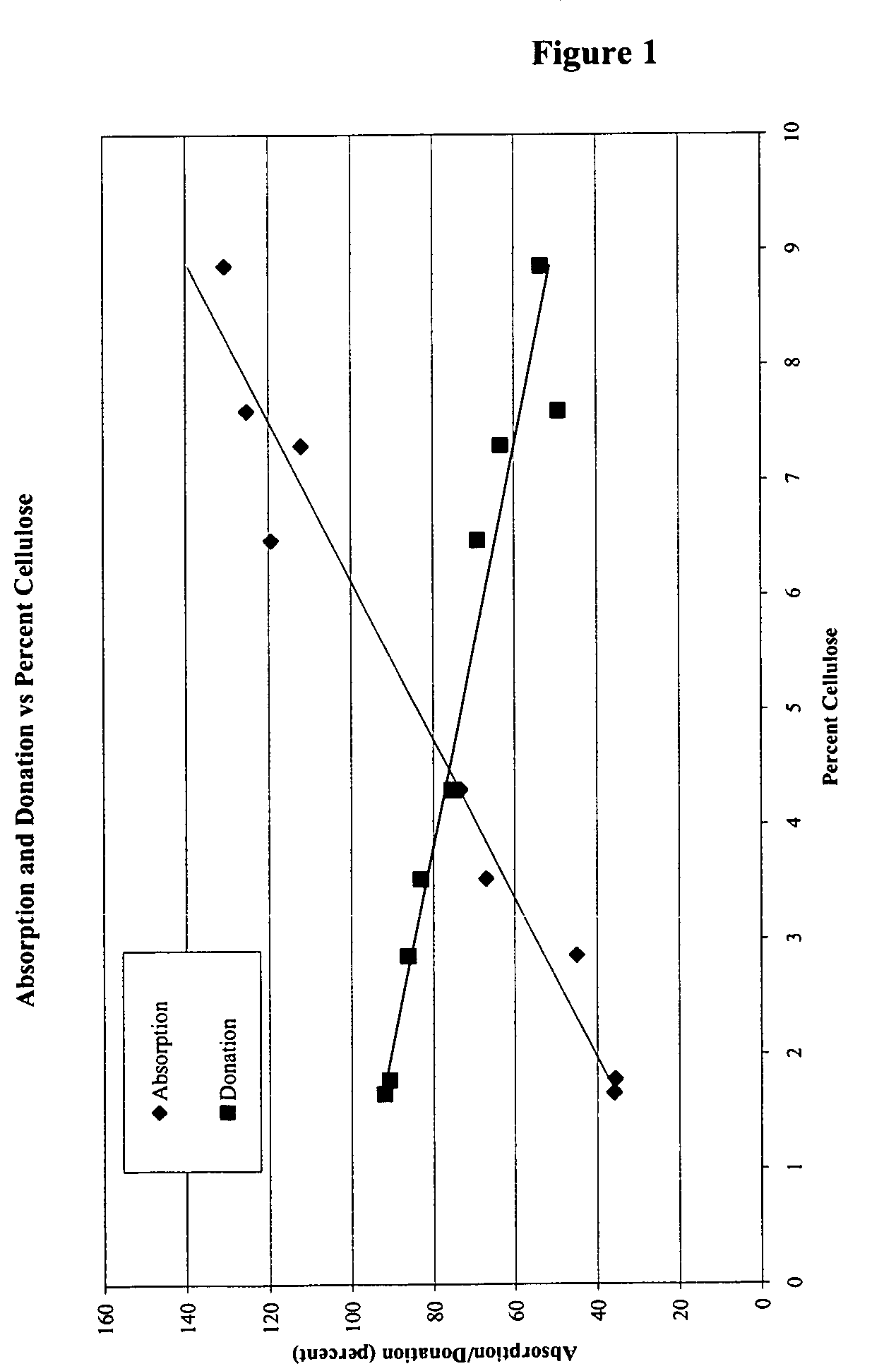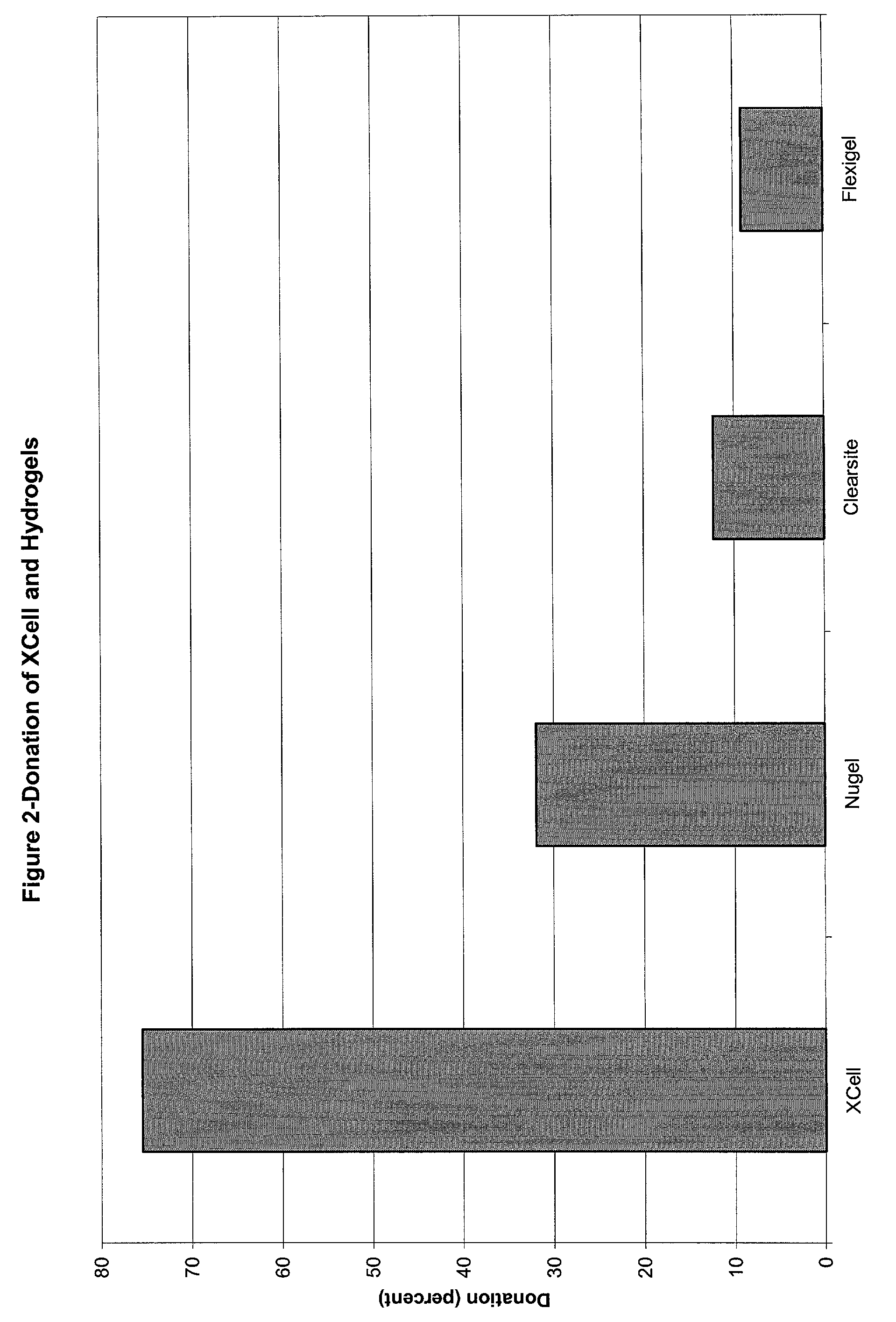Microbial cellulose wound dressing for treating chronic wounds
a wound dressing and microorganism technology, applied in the field of wound dressings, can solve the problems of limited exudate absorption and residue deposition on the wound site, high cost, and undesirable residue deposition, and achieve the effect of optimizing wound healing
- Summary
- Abstract
- Description
- Claims
- Application Information
AI Technical Summary
Benefits of technology
Problems solved by technology
Method used
Image
Examples
example 1
Absorption / Donation Studies
[0038]Cellulose pellicles of varying thickness were produced and processed to remove cellular debris. Pellicles were compressed to a uniform thickness of 1.9 mm, yielding a series of films with cellulose contents ranging from 1.5% to 10%. These films were tested for the ability to absorb saline from a saturated surface, and to donate moisture to a dry surface.
[0039]Weighed samples of uniform area were placed on the surface of a saturated sponge. Saline was poured around the sponge to maintain saturation. After 24 hr, the samples were reweighed to determine absorption, which was then plotted as percent of initial sample weight. To determine the moisture donation, weighed samples of uniform area were placed on the surface of smooth, dry leather. The leather was weighed prior to addition of sample. After 2 hr, the sample was removed and the leather was reweighed to determine the quantity of moisture that was donated, which again was plotted as percent of the ...
example 2
Biocompatibility Testing
[0043]The sterile cellulose wound dressing was subjected to the following biocompatibility tests: 1) Guinea pig sensitization, 2) Primary irritation in rabbits and, 3) Cellular cytotoxicity. In the sensitization test, extracts of the product were injected into six guinea pigs. The body temperatures of the guinea pigs were monitored for any sensitization reaction during the 8-10 week study period. The results showed no evidence of delayed dermal contact sensitization in the guinea pigs. The Primary irritation test was a two-week study using rabbits. In this test extracts of the cellulose dressing were injected subcutaneously and the skin was observed for any irritation reactions. The results showed that there was no evidence of significant irritation or toxicity from the subcutaneous injection of the extract into rabbits. The Primary Irritation Index of the cellulose dressing extract was found to be negligible. Finally, the cytotoxity of the dressing with mamm...
example 3
Wound Healing in Animal Models
[0044]The objective of animal pre-clinical studies was to compare the wound healing performance in animal porcine models of the microbial derived cellulose wound dressing with existing wound dressing products such as hydrocolloids and hydrogels.
[0045]The test was conducted using the porcine model protocol of the Department of Dermatology of the University of Miami School of Medicine in compliance with Association for Accreditation of Laboratory Animal Care (AAALAC).
[0046]Briefly, the test was conducted on 2 pathogen-free pigs over a seven-day period. Approximately 140 rectangular wounds (10×7×0.3 mm) were made in the paravertebral and thoracic area of each pig with a specialized electrokeratome fitted with a 7 mm blade. The wounds are separated from one another by a 15 mm of unwounded skin. About 35 wounds were randomly assigned to each wound dressing treatment group of cellulose, hydrocolloid, hydrogel and no dressing / air exposed. An epidermal migratio...
PUM
| Property | Measurement | Unit |
|---|---|---|
| temperature | aaaaa | aaaaa |
| time | aaaaa | aaaaa |
| time | aaaaa | aaaaa |
Abstract
Description
Claims
Application Information
 Login to View More
Login to View More - R&D
- Intellectual Property
- Life Sciences
- Materials
- Tech Scout
- Unparalleled Data Quality
- Higher Quality Content
- 60% Fewer Hallucinations
Browse by: Latest US Patents, China's latest patents, Technical Efficacy Thesaurus, Application Domain, Technology Topic, Popular Technical Reports.
© 2025 PatSnap. All rights reserved.Legal|Privacy policy|Modern Slavery Act Transparency Statement|Sitemap|About US| Contact US: help@patsnap.com



